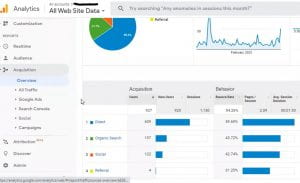 I’m Jeremy Bloom (a.k.a. the Internet Farmer). Being a software nerd of over 25 years, I’ve helped small-scale farmers and food business owners with their online needs. I have experience working on farms and creating some of the first co-op buying software out there. After teaching a class on E-commerce Best Practices for the recent Ag and Food Producers Academy I thought I would share some of the main takeaways. We’ve come a long way in recent years with E-commerce thanks to the pandemic, and in the local food scene it’s become a game changer. It’s been an interesting twist to the online sales world during this odd time in our history.
I’m Jeremy Bloom (a.k.a. the Internet Farmer). Being a software nerd of over 25 years, I’ve helped small-scale farmers and food business owners with their online needs. I have experience working on farms and creating some of the first co-op buying software out there. After teaching a class on E-commerce Best Practices for the recent Ag and Food Producers Academy I thought I would share some of the main takeaways. We’ve come a long way in recent years with E-commerce thanks to the pandemic, and in the local food scene it’s become a game changer. It’s been an interesting twist to the online sales world during this odd time in our history.
1. Cyber Security
This includes your domain name access, usernames/passwords and webmasters.
Control your domain name.
- Which means, have a username and password for access to your domain so you can make changes if need be. If you don’t have access, question who you are working with.
- Why do you need access? When your site goes down because your friend didn’t renew it and has left to sail the open sea, you’re not going to be happy when you’re offline until they get back.
Manage your usernames and passwords
- E-commerce connects to banks, emails, personal customer information, and is the lifeline to your sales.
- In many cases, you can set up a user name and password to give limited access to someone you’re working with. It can be a pain, but remember to change the password when the person is done working with you.
- Get a password manager like LastPass. This tool saves tons of time on so many levels of managing usernames and passwords.
Friends and family can be webmasters, but not professionally.
- Software is fun to tinker with and anyone can set up a domain and website that looks awesome on the surface. But are they thinking of your best interest for the long haul?
- Whether it’s your friend, a family member or a webmaster, do not let them set up a domain if you don’t get a username and password to it. You want to have direct control over the billing.
2. Analytics
E-commerce helps you see successes and can correct errors in your thinking.

Track past performance
- For me this has always been a great equalizer – having the tools once only found in the corporate world right at my fingertips, giving me facts instead of guesses in my small business.
- Analytics is how we review the past. The sales, the clicks, emails sent and opened, the page views, ad views, etc.
- I like to set up Google Analytics (GA) as a 3rd party powerhouse of analytics, and most software will have its own analytics tools.
- What’s great is that GA is built into almost all the online platforms out there so that no matter what sites you work with for shopping, or surveys, or the home site, they all get tracked under one umbrella. If you move services (like switching shopping carts), GA keeps on counting once it’s set up. Setting it up is often just putting a simple number into your online software.
Organize and track your progress
- Making simple spreadsheets with vital statistics that are pulled from various places can be useful in tracking your progress.
- KPIs (Key Performance Indicators) are all those “vital stats” that matter and need to be reviewed. Website traffic, advertising performance on Google or Facebook, sales overall, emails sent, sales by product, offline sales, etc. Make up your own reporting to review. List them out and look them up in your analytics.
3. Testing
Review your work so you can avoid errors that can waste your and your customer’s time. Wouldn’t it stink to spend a whole day putting together a promotion only to find out your website didn’t work and no sales were made?
- If you make any adjustments to your products, test it through to purchase.
- If you change a link in your email, test that it goes to the right place.
- If you add new pictures, test them – on mobile devices too!
4. Product Names
Use formats that are friendly both to people, and to how products list on a page.
- Consistent and clear product naming will give search engines more keywords and better detail to show on search results, as well as help customers know what it is they are buying. If products are listed alphabetically then you are able to get all the like products together like carrots or microgreens.
- “Carrots” means very little to anyone buying online who loves vegetables. There’s baby carrots, 2nds, 1lb bags, 20lb bags, rainbow, purple, etc. So what is it?
- Carrots – Rainbow – 1lb Bag – Organic
- The format is general name, descriptive name – size/package – info, though you can adjust this however is appropriate to you.
- Carrots – Rainbow – 1lb Bag – Organic
- Other products might look like this:
- Microgreens – Radish – 1lb box – each
- Jam – Triple Berry – 8oz jar – case of 12
- Farm Tour – April 10th – 8-9pm
5. Product Description
This is the best way to educate and sell to consumers and optimize search engine results.
- What’s the variety? Where did it come from? Is there a history to this product that you should talk about? Are you sharing recipes?
- Many do not bother with a product description, and that might be okay if it feels clunky or out of place.
- If you’re just getting started, a product description might be a secondary step.
- Search Engine Optimization (SEO), how and where you show up in search engines, can take all of your time and results are often fuzzy or even unattainable. You’re better off running an ad.
6. Image Optimization
Images need to be “small” to load quickly on websites.
- Images should not go online as you took them. Our cameras and phones take high resolution pictures with large file sizes and take too long to upload to the site, and for customers to view. You’ll want to make adjustments.
- Use apps like Squoosh to reduce file sizes and here are 15 others online.
- Create a process for getting photos online. Making photo sizes as small as possible without degrading the quality for your customers. It’s repetitive work almost anyone can learn.
- Photos are often important for selling online, but if you have a knowledgeable customer base you may not need to tinker with images at all if descriptive product names do the job.
7. Shipping & Return Policies
Your shop policies should be visible in your shopping cart.
- It doesn’t have to be long and complicated, but your policies should be clear. At the very least, fill in those fields in your shopping cart if they exist, because that information is used in your checkout process and email receipts.
- When shipping and return policies are noticeable to customers, there should be no issues when the customer comes back and says they want a return; policies are clear and available.
- You may want to make the return policy a page on your website so it lives in a permanent place and is always viewable for customers. Within your shopping cart you can link to the policy, or just copy it over.
Thank you for joining me on this adventure in Best Practices for E-commerce. I hope these best practices help you succeed for the life of your online business.
Jeremy Bloom has twenty-five years of e-commerce experience. He is a consultant for food and farm businesses, and enjoys spending time on farms. See him online.

